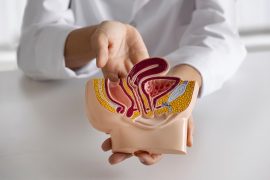Introduction
When two body cavities or a body cavity and skin connect abnormally, they form a fistula. A fistula can be formed in many parts of the body, namely between the cervix and vagina, the neck and the throat, an artery, and a vein, the bowel and vagina, stomach and skin surface, anus and skin surface, skull space, and nasal sinus. These fistulas could be open (one end open), complete (both ends open), incomplete (closed inside), or horseshoe (connecting the anus to the skin surface). Some fistulas may heal on their own, while some may not. The treatment depends on the type, location, cause, and severity of the condition.
An anal fistula is one such types of fistula that most commonly affect men. Following an infected anal gland that does not heal, it needs surgical treatment for its cure.
The present blog provides insight into the meaning, causes, symptoms, diagnosis, and treatment of anal fistula for a better understanding of the condition.
What is an Anal Fistula?
An anal fistula, also known as a Fistula-in-Ano, is an abnormal connection between the surface of the skin of the bullock and the anal canal in the colon. It is a tunnel running from inside the anus to the skin surface around it. An anus is an opening at the end of the digestive tract that gets rid of the solid waste of the body. Anal fistula affects the internal and/or external anal sphincters (muscles).
What Causes Anal Fistula?
An infection in the anal gland is the primary cause of anal fistula. This infection causes an abscess. An abscess is a tender mass over skin filled with pus and bacteria, painful and warm to feel.
The other cause of anal fistula includes –
- an injury or surgery in the anus,
- radiation therapy in the pelvic region,
- tuberculosis (infection in the lungs),
- Crohn’s disease (inflammation of the digestive tract),
- ulcerative colitis (inflammation of the large intestine) or
- sexually transmitted diseases.
Symptoms of Anal Fistula?
Anal fistula symptoms require immediate medical consultation and intervention for its treatment. Some of the symptoms of anal fistula are-
- Fever
- Swelling and redness around the anus,
- Pain during bowel movement or urination
- Fowl smelling pus or watery discharge from the abscess
- Bleeding
How is Anal Fistula Diagnosed?
The diagnosis of anal fistula starts with medical history and physical examination of the patient. Some fistulas can be easily spotted, and the doctor may examine through the oozing blood fluid.
For those that are closed, the doctor may need to find the inside source of the fistula. For this, they may use an anoscope or a proctoscope to examine the anal canal. The patient is put on anesthesia during the examination.
The use of special dye to find the internal source of the anal fistula is also resorted to by the doctor. For this, the doctor injects a special dye that would react with the infection, creating bubbles at the injection site.
Ultrasound and MRI are some of the imaging studies that the healthcare provider may conduct for the diagnosis of anal fistula.
Treating Anal Fistula
The treatment for anal fistula depends on the severity of the condition and the type of fistula. Before arriving at the decision for anal fistula surgery, the healthcare provider may try to treat it with medications. However, spontaneous healing may cause the fistulas to reopen if there is infection again. The treatment varies depending on whether the fistula is simple or complex. Simple fistula has less muscle involved that needs to be treated. Complex fistula treatment requires addressing more muscle damage. The treatment options for fistula are-
- Fistulotomy– Fistulotomy is the most common one-time surgery for simple fistulas. The surgeon cuts through the fistula, opens the infected area, and removes the damaged muscle.
- Seton drain– For complex fistulas, the surgeon uses a surgical thread called the seton that keeps the fistula open and helps drain the infection. The seton is passed from the opening of the fistula through its track out to the anus with a loop at the end. It acts as a wick to drain the infection and heal the fistulas. Later, it may be closed with a fistulotomy. A seton is generally required to be removed; however, in some cases, it might be placed for an indefinite time.
- Endorectal advancement flap– The infection is accessed through the inside opening of the fistula and cut out. The opening is then covered with healthy tissue from the inside of the rectum above it. This flap of the healthy tissue is pulled down from the rectum to fill the opening. The infection drains out from the outside of the fistula opening. In some cases, there are chances of reoccurrence of infection and fistula, along with the risk of damaging the muscles.
- LIFT- The procedure is known as the Ligation of the Intersphinteric Fistula Tract. It avoids cutting the sphincter muscles. The surgeon accesses the fistula between the internal and external muscles through an incision at the anal track opening and treats the infection, and then closes the incision with stitches.
Conclusion
Fistulas are not life-threatening; however, they may become life-challenging, affecting the patient’s quality of life. Anal fistulas usually need to be treated surgically depending on the severity and location of the fistula. A timely address requires an informed decision based on the risk assessment and successful surgical outcomes of the various treatment options. Living with a fistula is challenging, and its treatment varies depending on its severity and complexity. Immediate and timely medical intervention is the only way to treat it, enabling quality and healthy living.
References
https://my.clevelandclinic.org/health/diseases/14466-anal-fistula
https://www.mayoclinic.org/diseases-conditions/anal-fistula/symptoms-causes/syc-20352871
https://www.webmd.com/digestive-disorders/anal-fistula-overview
https://www.hopkinsmedicine.org/health/conditions-and-diseases/anal-fistula
https://www.pennmedicine.org/for-patients-and-visitors/patient-information/conditions-treated-a-to-z/fistula





Comments are closed.